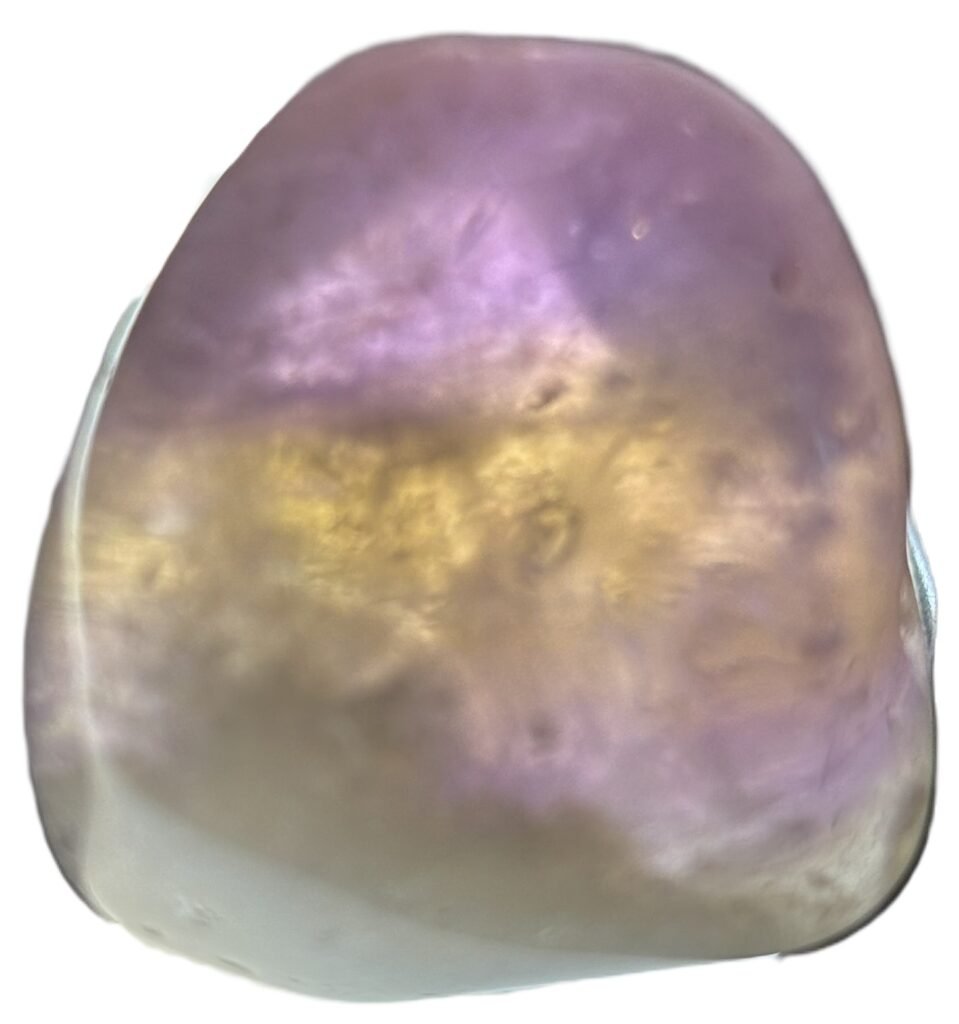Ametrine is a unique variety of quartz that combines the purple hues of amethyst with the golden tones of citrine in a single crystal. Its name is a fusion of “amethyst” and “citrine,” reflecting its dual composition. Historically, it has also been referred to as “trystine” or “bolivianite,” the latter name being derived from its primary source in Bolivia.
Composition and Physical Characteristics
Ametrine is a naturally occurring macrocrystalline variety of quartz (SiO2). Its distinctive bi-coloured appearance results from differing oxidation states of iron within the crystal, influenced by temperature variations during its formation.
Physical Properties:
- Colour: A striking combination of violet and yellow-orange hues
- Hardness: 7 on the Mohs scale (durable and suitable for jewellery)
- Lustre: Vitreous
- Transparency: Transparent to translucent
- Cleavage: None, but exhibits conchoidal fracture
- Formation: Develops in silica-rich hydrothermal veins under specific temperature conditions that allow the formation of both amethyst and citrine in the same crystal structure
Varieties of Ametrine
While ametrine typically exhibits a blend of purple and yellow, variations exist depending on the intensity of each colour. Some specimens may have:
- Equal distribution of amethyst and citrine hues
- Dominant amethyst with subtle citrine tones
- More prominent citrine with slight amethyst tint
Locations
The only significant natural source of ametrine is:
- Bolivia – Found in the Anahi Mine, located in the Santa Cruz region, which has been the primary commercial source since the 17th century.
Other locations may produce artificially treated ametrine, created by heat treatment or irradiation of quartz to mimic the natural colour zoning.
Archaeological and Significant Finds
Ametrine’s historical significance dates back to the 1600s when Spanish conquistadors discovered it in Bolivia. According to legend, a Spanish conquistador received an ametrine gem as a dowry when he married a native princess of the Ayoreo tribe. He later introduced it to Europe, where it became prized among royalty.
Historical and Current Usage
Historical Uses:
- Ametrine was initially used as a rare and exotic gemstone in European aristocratic jewellery.
- Indigenous South American cultures valued it for its believed spiritual and healing properties.
Modern Uses:
- Jewellery: Used in rings, pendants, earrings, and bracelets, often cut in ways that highlight its bi-colour effect.
- Decorative Objects: Carved into ornamental figurines and gemstone sculptures.
- Metaphysical and Healing Practices: Believed to balance energy, enhance mental clarity, and promote creativity.
Interesting Facts
- Natural ametrine is found almost exclusively in Bolivia, making it a relatively rare gemstone.
- Some synthetic or treated quartz is sold as ametrine, so authentication is crucial when purchasing high-quality specimens.
- The colour zoning in ametrine is natural and unique to each stone, meaning no two pieces are exactly alike.
Folklore, Legends, and Tales
Ametrine is often linked to harmony and balance, as it symbolises the blending of two distinct energies. In mystical traditions, it is believed to bridge the gap between physical and spiritual realms, helping individuals achieve higher states of consciousness.
A Bolivian legend states that the gemstone was a gift from the gods to unite the energies of the Earth and the heavens, offering protection and wisdom to those who possess it.
Astrology and Zodiac Links
Ametrine is associated with:
- Libra – Promotes balance, harmony, and clear decision-making.
- Gemini – Enhances intellectual abilities and supports adaptability.
- Pisces – Encourages spiritual growth and inner peace.
Chakra System Connections
Ametrine is thought to align multiple chakras:
- Crown Chakra – Enhances spiritual awareness and connection to higher consciousness.
- Third Eye Chakra – Stimulates intuition and insight.
- Solar Plexus Chakra – Boosts personal power, confidence, and mental clarity.
Birthstone and Wedding Anniversary Links
- Birthstone: Ametrine is sometimes considered an alternative birthstone for November due to its citrine component.
- Wedding Anniversary: While not an official anniversary stone, it is a meaningful gift for celebrating milestones that symbolise balance and unity in relationships.

Ametrine
Balancing the energies of Amethyst and Citrine, Ametrine promotes clarity, creativity, and harmony. Ideal for decision-making and spiritual alignment.
